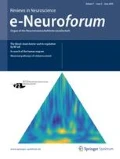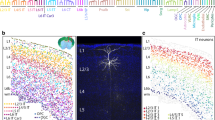Abstract
The neocortex is regarded as the brain structure responsible for mediating higher brain functions, like conscious perception of sensory signals, learning and memory or programming of goal-directed behavior. Cortical circuits that enable these functions are formed by, first, a larger population of excitatory so-called principal cells (i.e., glutamatergic pyramidal cells; ca. 80–85 %), which issue long-distance projections, in addition to local recurrent collaterals, which form the major part of local cortical excitatory circuits. A second, smaller population of inhibitory also called local or short-axoned interneurons (i.e., GABAergic neurons; ca. 15–20 %), however, contribute heavily to intracortical microcircuits too. They can be subdivided by their location in specific areas, layers, or columns, which possess specific input–output relationships, but also in terms of morphology, electrophysiology, molecular expression profiles, and subcellular target specificity. Here it is proposed that, at present, in the rodent neocortex this population of GABAergic neurons can be reasonably divided into six different types, mainly due to their unique axonal patterns and subcellular target specificity: (i) axo-axonic cells, (ii) basket cells, (iii) Martinotti cells, (iv) bipolar/bitufted cells, (v) neurogliaform cells, and (vi) projection neurons. These different types of GABAergic neurons strongly govern the working of cortical circuits for meaningful behavior by feed-forward and feedback inhibition as well as disinhibition. Thus, they keep excitation in check, perform gain modulation, and open temporal or spatial windows for input control or output generation.




Similar content being viewed by others
References
Ascoli GA et al (2008) Petilla terminology: nomenclature of features of GABAergic interneurons of the cerebral cortex. Nat Rev Neurosci 9:557–568
De Felipe J et al (2013) New insights into the classification and nomenclature of cortical GABAergic interneurons. Nat Rev Neurosci 14:202–216
Fairen A, De Felipe J, Regidor J (1984) Nonpyramidal neurons. In: Peters A, Jones EG (eds) Cellular components of the cerebral cortex. Plenum Press, New York, pp 201–254
Fu Y, Tucciarone JM, Espinosa JS, Sheng N, Darcy DP, Nicoll RA, Huang ZJ, Stryker MP (2014) A cortical circuit for gain control by behavioral state. Cell 156:1139–1152
Karnani MM, Agetsuma M, Yuste R (2014) A blanket of inhibition: functional inferences from dense inhibitory connectivity. Curr Opin Neurobiol 26C:96–102
Pfeffer CK, Xue MS, He M, Huang ZJ, Scanziani M (2013) Inhibition of inhibition in visual cortex: the logic of connections between molecularly distinct interneurons. Nat Neurosci 16:1068–1076
Roux L, Buzsaki G (2015) Tasks for inhibitory interneurons in intact brain circuits. Neuropharmacology 88:10–23
Rudy B, Fishell G, Lee S, Hjerling-Leffler J (2011) Three groups of interneurons account for nearly 100 % of neocortical GABAergic neurons. Dev Neurobiol 71:45–61
Silberberg G, Markram H (2007) Disynaptic inhibition between neocortical pyramidal cells mediated by Martinotti cells. Neuron 53:735–746
Tamas G, Lorincz A, Simon A, Szabadics J (2003) Identified sources and targets of slow inhibition in the neocortex. Science 299:1902–1905
Taniguchi H, Lu JT, Huang ZJ (2013) The spatial and temporal origin of chandelier cells in mouse neocortex. Science 339:70–74
Tomioka R, Okamoto K, Furuta T, Fujiyama F, Iwasato T, Yanagawa Y, Obata K, Kaneko T, Tamamaki N (2005) Demonstration of long-range GABAergic connections distributed throughout the mouse neocortex. Eur J Neurosci 21:1587–1600
Acknowledgments
Many thanks to the members of the Barrel Cortical Circuits Group for helpful discussions. This work is supported by the German Research Council (DFG) since 1997. We sincerely apologize to all colleagues whose great research could not be referred due to limited space and the special focus of this review article.
Author information
Authors and Affiliations
Corresponding author
Rights and permissions
About this article
Cite this article
Staiger, J., Möck, M., Proenneke, A. et al. What types of neocortical GABAergic neurons do really exist?. e-Neuroforum 6, 49–56 (2015). https://doi.org/10.1007/s13295-015-0006-y
Published:
Issue Date:
DOI: https://doi.org/10.1007/s13295-015-0006-y




